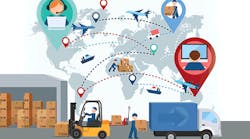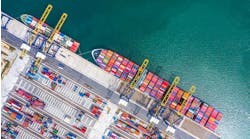If your organization's supply chain is global, then you're well aware that one of the greatest obstacles to increased speed and efficiency can be summarized in one word: Customs. Today, businesses and economies around the world are increasingly interconnected, and advances in technology and transportation have rewritten old logistics formulas. Unfortunately, Customs and border security agencies have been slower to adopt new strategies, in part because of the complex security challenges that they face.
But with continuing calls to modernize the entire border clearance process and a strong move to automate Customs procedures, the story is beginning to change. Customs agencies in countries around the globe, including here in the United States, are moving to make the complex process of filing documentation for international shipments easier, and to create more uniformity in the processing and releasing of shipments from one point of entry to another. To be successful in this evolving environment, logistics managers and other key leaders across the supply chain need to keep a close watch on new developments.
Each year, an increasing number of U.S. companies begin to engage in international trade, intensifying the need for up-to-date international logistics expertise. Consider that more than 28% of the U.S. GDP is now tied to trade, according to the U.S. Chamber of Commerce, and you get a sense of just how economically important it is to build greater efficiencies into the border clearance process. And when you understand that less than 1% of approximately 30 million U.S.-based companies are currently involved in exporting, as reported by the Department of Commerce's International Trade Administration, you get a clear idea of just how much more trade growth is possible in the future—and how critical it will be to keep shipments moving quickly on a global scale.
With this in mind, let's take a look at how Customs processes are changing, and at some of the logistics challenges facing today's logistics and supply chain executives.
Automation
For those moving goods into and out of the U.S., the push for speed often runs up against the reality of border clearance requirements. While U.S. Customs and Border Protection (CBP) is primarily responsible for the processing, screening and clearance of imports and exports on the U.S. side, 47 different U.S. government agencies may be involved in the process, and each has historically required the filing of documentation for certain goods.
The CBP's move to implement the Automated Commercial Environment (ACE), which should be fully operational in 2016, will consolidate and streamline the export and import process, providing one automated system for entry processing, cargo release and export processing. Without ACE, a paper-based system requires importers and exporters and their logistics agents to submit the same data to different agencies, and it requires the same information to be keyed in manually to multiple electronic systems. With ACE and the single window, information can be submitted and processed quickly, for use by multiple government agencies for review and clearance.
Importantly, in the future, automation should allow for better cooperation among Customs agencies in different countries, so that information can be shared for faster and more secure border processing globally. Progress toward full-scale automation of Customs procedures is in various stages of development in different countries, creating a challenge for logistics managers as they implement their own strategies.
Over time, automation will mean that the cumbersome process of complying with multiple and changing requirements and regulations from country to country should become easier. Ultimately, automated systems may allow faster clearance throughout the entire process: lodging, acceptance and processing of cargo; goods declarations for import, export and transit; payment of applicable duties and taxes; and release of goods from Customs.
Trusted Trader Programs
To keep your international supply chain moving fast, it is essential to understand how Trusted Trader programs can play a role. CBP's Customs-Trade Partnership Against Terrorism (C-TPAT) program provides an avenue for certain importers to receive expedited processing benefits. Companies that apply to participate in C-TPAT must first undergo an evaluation and security assessment. If approved, they can expect a reduced number of CBP examinations of their shipments, shorter wait times at the border, and eligibility to participate in other U.S.
Government pilot programs, such as the Food and Drug Administration's Secure Supply Chain program.
The CBP is also in the testing phase of a new Trusted Trader program that will expand C-TPAT.
The Challenge of Duties and Taxes
Because there is still no single automated process that can be used from country to country, the task of understanding and estimating duties and taxes presents a clear challenge. Duties and taxes are imposed on dutiable goods that move across political boundaries; they are enforced by local Customs authorities and are subject to changing rules that vary from country to country. A shipment is considered "dutiable" when the goods shipped are part of a sales transaction and are for permanent export.
Duties and taxes can vary depending on the commodity's classification code, value, country of manufacture and associated freight charges. For example, cars and alterations made in another country to clothes already owned are both dutiable. Each country establishes its own standards as to which goods are considered non-dutiable or dutiable.
While international logistics managers are aware of the complexities involved in the duties and taxes estimation and payment process, a review of the general procedure can shed some light on this important part of the logistics equation. Customs uses the following information found on the Commercial Invoice to calculate the duties, taxes and fees that are applied to a shipment: Harmonized System (HS) codes (classification codes) for each commodity; the country of manufacture; total costs of the goods (commodities); and other associated freight charges. For example, an electric guitar and amplifier being shipped from the U.S. to the U.K. has a 3.7% and 2.7% duty tax rate, respectively. Customs uses this percentage against the value, freight and any other incremental charges that resulted in the sale of the merchandise to determine the total costs.
Shippers also need to know that the HS code they assign to their goods on export documentation may not be the same as the one used at the destination country—and it's the destination country HS code that is used in calculating the duty and tax charges.
Typically, the receiver pays Customs charges prior to delivery. A Customs broker or shipping partner may contact the designated payer on behalf of Customs to arrange for payment of duties, taxes and fees, which can help streamline the process. To avoid shipments being held until the payment of duties or taxes are made, some international logistics and shipping companies offer special services to expedite payment, such as allowing customers to pay Customs charges by including their account number on the waybill.
Until a multi-country, automated and coordinated system for paying Customs fees is established, the best way to avoid delays and difficulties in the border clearance process is to understand its intricacies, and to work with logistics experts who are up to speed on the changing environment. With the right information and support, your global supply chain can be as fast and productive as any domestic equivalent.
Amy Smith, head of U.S. Customs & Trade Compliance for DHL (www.dhl.com), is responsible for all aspects of import and export trade compliance for DHL's international service. She previously served as clearance director at the company's Cincinnati hub facility. She has worked with Customs, Agriculture and FDA at all DHL ports for entry. She is a National Corporate License Holder as well a Certified NCBFAA Customs Specialist and Licensed Customs Broker.



